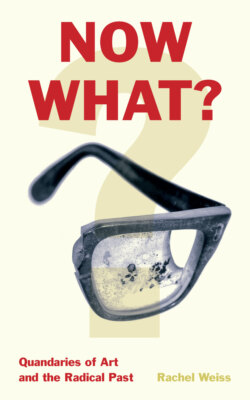Now What?

Реклама. ООО «ЛитРес», ИНН: 7719571260.
Оглавление
Rachel Weiss. Now What?
Отрывок из книги
NOW WHAT?
QUANDARIES OF ART AND THE RADICAL PAST
.....
Recent works—the mic, the horses, taunting an audience in Bogotá with lines of cocaine—come at a time when Bruguera has built up enough leverage to be strategic, to exercise strategic maneuvers. Maybe this is one reason they can feel so iffy, because they’re her building power and testing it, while arts discourse in general is bending over backward in favor of a tactical approach.
These days in art it’s all about tactics. Tactics are how guerrillas fight; they’re intrinsically inventive and unorthodox. Tactics are for people unencumbered by a home base they have to protect, and art likes them because they’re associated with wit: Tactical trickery is a witty handling of weakness. Being tactical is a way to live in ripple effects of refusal. It’s agile and observant and bold; it hands you surprises, “cracks and lucky hits in the framework of a system.”11 Power, meanwhile, plans, and the strategic plods along with its force in heavy tow. It seems like a pretty risky artistic strategy to take on the role of power, to be willing to be associated with it in political and moral terms. Maybe it’s just because Bruguera grew up with the experience of an absolute form of power, but it seems to me that she’s not very romantic in her view about the struggle against it. At least, not romantic in the ways that contemporary art has tended to be, with its resort to micropolitics and convivial relations. Artists rarely align with power, and when they do it’s generally in the form of money, but Bruguera designs situations where she wields control, even manipulation, and she does that unapologetically and, apparently, unreservedly. Tactics are opportunistic, non- or extrainstitutional, but Bruguera’s performance at the mic waded deep into the negotiated, compromised territory of the most intransigent institution, the place where the state’s performance is most artfully choreographed.
.....